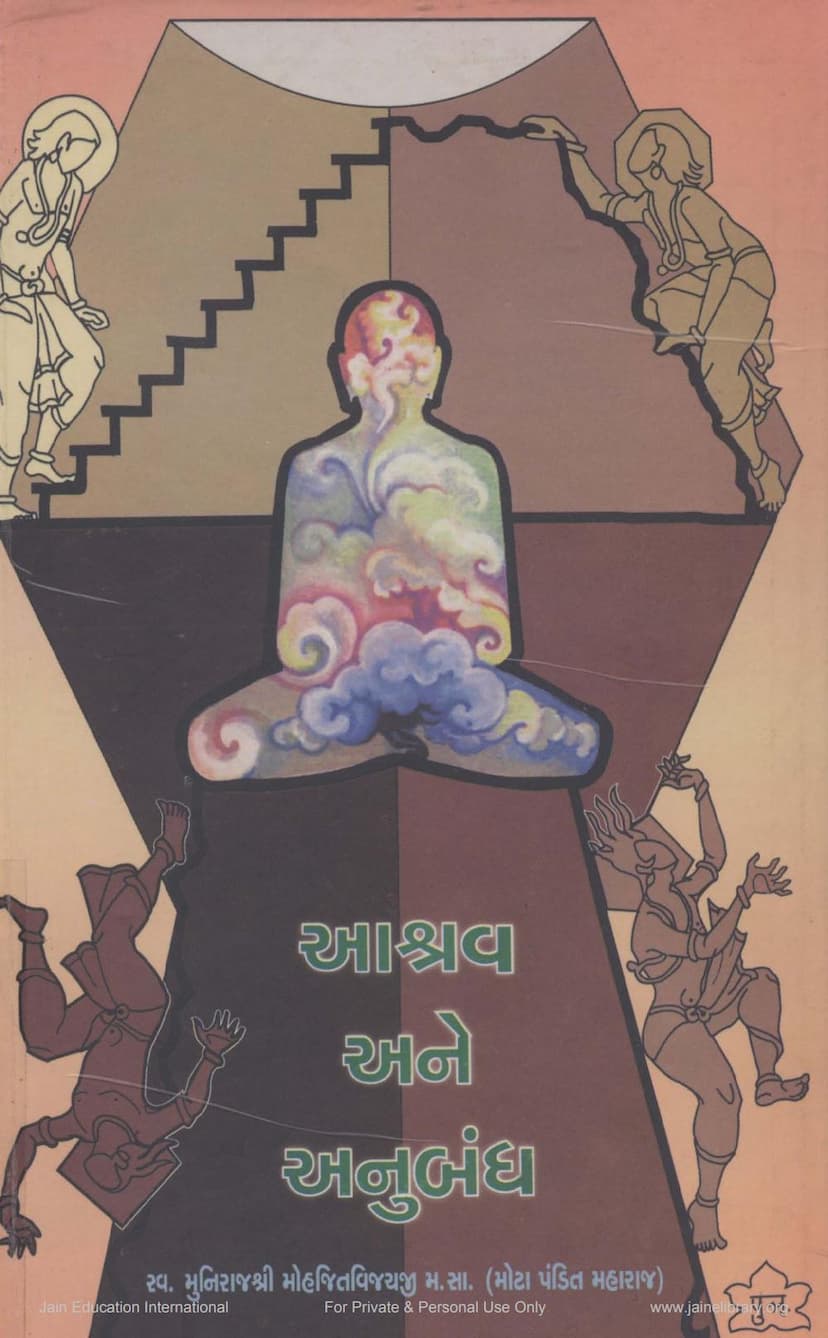Ashrav Ane Anubandh
Added to library: September 1, 2025

Summary
Here's a comprehensive summary of the Jain text "Ashrav ane Anubandh" by Mohjitvijay, based on the provided pages:
Book Title: Ashrav ane Anubandh (The Influx of Karmas and Their Consequence) Author: Muni Shri Mohjitvijayji Maharaj (known as "Mota Pandit Maharaj") Publisher: Gitarth Ganga Theme: The book delves into the Jain philosophical concepts of Ashrav (influx of karmas) and Anubandh (the causal link and consequences of karmas), offering detailed explanations and insights through the spiritual discourses of Muni Shri Mohjitvijayji Maharaj.
Core Concepts Discussed:
-
Ashrav (Karma Influx): The text explains Ashrav as the process by which karmic particles attach to the soul. This influx is caused by the soul's activities involving mind, speech, and body (yog). It clarifies that this influx is a natural phenomenon governed by universal laws (loksthiti) and that even Tirthankaras, while free from gross attachment and aversion, still experience yogic vibrations which lead to the influx of subtle karmas like Shata Vedaniya. The core causes of Ashrav are identified as Mithyatva (false belief), Avirati (lack of self-control), Kashay (passions like anger, pride, deceit, greed), and Yog (mind, speech, body activities).
-
Anubandh (Causal Link & Consequences): Anubandh refers to the latent potential within previously bound karmas that, when they mature, lead to specific auspicious or inauspicious results through the resulting subtle mental states (bhavas) and passions, which in turn bind new karmas. The text emphasizes that wise individuals prioritize understanding and controlling the Anubandh over the mere act of binding. The book thoroughly analyzes Anubandh from various perspectives:
- Dravya-Kshetra-Kaal-Bhav (Substance, Place, Time, and State)
- Vyavahar-Nishchay Naya (Conventional and Absolute Truth)
- The eighteen types of Paapsthanaks (vows/actions leading to sin)
- The stages of spiritual evolution (Gunasthans)
- The nature of Yog (mind, speech, body activity), Leshya (subtle states of mind influencing karma), and Adhyavasaay (mental disposition/intention).
-
The Vicious Cycle: The text highlights the continuous cycle of old karmas giving rise to attachment and aversion, which then bind new karmas, creating a "vicious circle" that perpetuates suffering in the cycle of birth and death (samsara). Understanding this cycle is crucial for liberation.
-
Nature of Reality: The book discusses the nature of soul (Jiva) as being cognizable and luminous, enabling infinite souls to reside in the same space-point in the liberated state (moksha) without mutual obstruction. It also touches upon the concept of subtle vs. gross results of karmas and how even subtle karmic matter does not cause obstruction for the liberated soul.
-
The Role of the Soul (Atma): The fundamental principle is that the soul is the agent and experiencer of karmas. The soul's results (parinaam) are the root cause of karma bondage. Ignorance of these principles keeps the soul trapped in the cycle of samsara. The text stresses that karmas are not random; they are a consequence of the soul's own actions and delusions.
-
Yoga, Kashay, and Leshya:
- Yoga: This refers to the vibrations in the soul's regions caused by mind, speech, and body. Complete cessation of yog occurs only at the highest spiritual stage (14th Gunasthanak). Even Kevalis (omniscient beings) have yog, leading to the binding of Shata Vedaniya karma, but without attachment or aversion. The core cause of karma bondage for ordinary souls is identified as strong attachment and aversion.
- Kashay: These are the passions (anger, pride, deceit, greed) that fuel the soul's restlessness and are the primary drivers of intense karma bondage.
- Leshyas: These are the subtle mental states that color the soul's consciousness and influence the type of karma bound. The text describes the six Leshyas (Krishna, Neel, Kapot, Tejo, Padma, Shukla) and their connection to the soul's disposition and the nature of karma. Pure Leshyas (Tejo, Padma, Shukla) are considered auspicious and lead towards liberation.
-
The Importance of Knowledge (Tattva Gyan): The text repeatedly emphasizes that Tattva Gyan (knowledge of reality, the nine fundamental principles of Jainism) is the only way to break free from the cycle of samsara. Ignorance of Tattvas is the very essence of delusion (Moha).
-
Means of Liberation: The discourses advocate for understanding the principles of karma, controlling the yog, managing Kashayas and Leshyas, and ultimately practicing Samyak Gyan (right knowledge), Samyak Darshan (right faith), and Samyak Charitra (right conduct) as the path to liberation.
-
Subtleties of Jain Philosophy: The book explores various other complex Jain concepts such as the different Nayas (perspectives), Bhangas (aspects), Pramanas (means of valid knowledge), the eighteen Paapsthanaks, and the Gunashthanaks (spiritual stages). It highlights the meticulous detail and logical framework within Jain philosophy.
-
Practical Application: The teachings are presented with the aim of enabling listeners to revolutionize their lives, shed delusions, cultivate detachment, control their senses, conquer passions, gain mastery over their yog, and ultimately achieve self-realization and liberation. The text encourages readers to internalize these principles and apply them in their daily lives.
Structure and Tone:
- The book is based on discourses delivered by Muni Shri Mohjitvijayji Maharaj, a highly respected and learned scholar ("Mota Pandit Maharaj").
- The discourses are presented in a question-and-answer format, with a "Sabha" (congregation) posing questions to the Muni, allowing for clarification and deeper exploration of the topics.
- The language is insightful, profound, and aims to provide practical guidance for spiritual growth.
- The content emphasizes the importance of intention (aashay), understanding cause and effect, and consistent spiritual practice.
- It stresses that while actions (karma) are important, the underlying intention and the causal link (Anubandh) are paramount in determining the spiritual outcome.
Overall Message:
"Ashrav ane Anubandh" serves as a profound guide to understanding the intricate workings of karma according to Jain philosophy. It aims to equip seekers with the knowledge necessary to navigate the complexities of spiritual life, break free from the cycle of suffering, and progress towards the ultimate goal of Moksha. The emphasis is on self-awareness, diligent practice, and unwavering adherence to the teachings of the Tirthankaras.